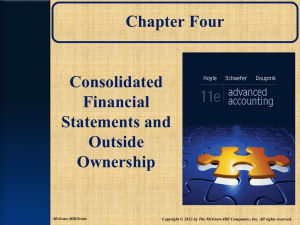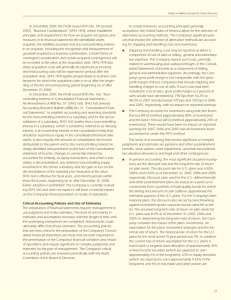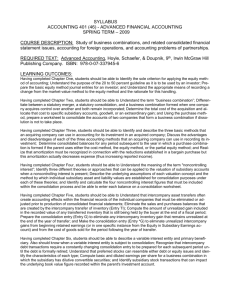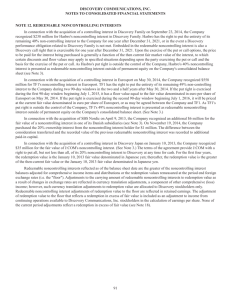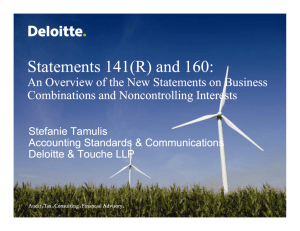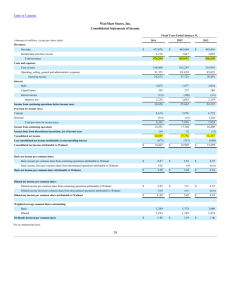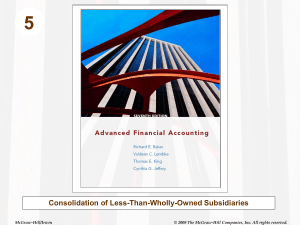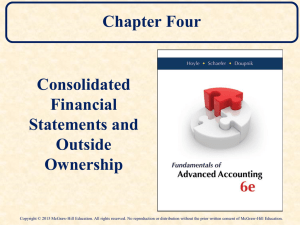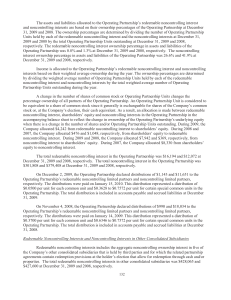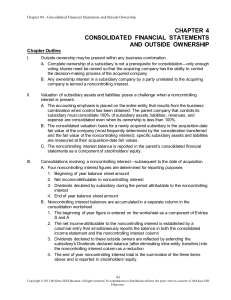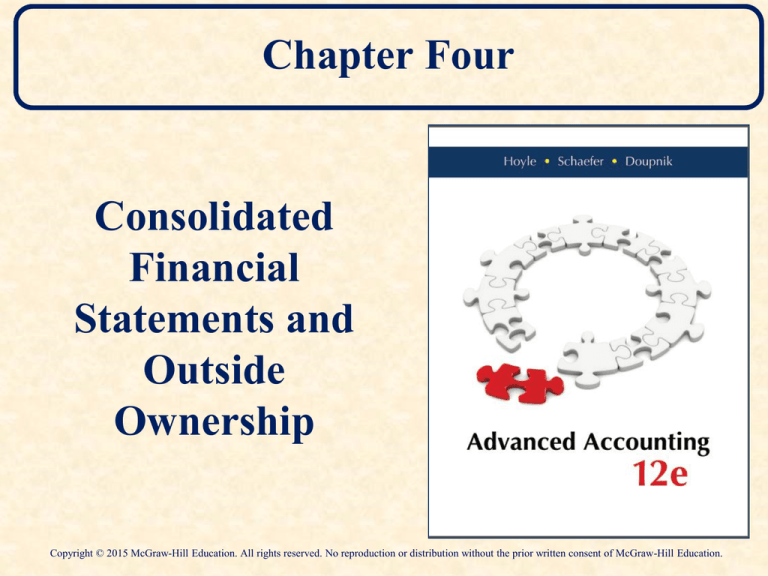
Chapter Four
Consolidated
Financial
Statements and
Outside
Ownership
Copyright © 2015 McGraw-Hill Education. All rights reserved. No reproduction or distribution without the prior written consent of McGraw-Hill Education.
Noncontrolling Interest
Learning Objective 4-1: Understand that complete ownership is
not a prerequisite for the formation of a business combination.
Although most parent companies do possess 100 percent
ownership of their subsidiaries, a significant number
establish control with a lesser amount of stock.
If the parent doesn’t own 100% of the company, WHO
owns the rest of it?
Noncontrolling Shareholders
The ownership interests of the Noncontrolling
Shareholders must be reflected in the consolidated
financial statements.
4-2
Noncontrolling Interest
Learning Objective 4-2:
Describe the valuation principles underlying the acquisition
method of accounting for the noncontrolling interest.
The Parent, with controlling interest, must consolidate 100% of
the Subsidiary’s financial information valued at the acquisitiondate fair value.
The total acquired firm fair value in a partial acquisition is the
sum of
The fair value of the controlling interest.
The fair value of the noncontrolling interest at the acquisition
date.
4-3
Noncontrolling Interest Example
Learning Objective 4-3:
Allocate goodwill acquired in a business combination across the
controlling and noncontrolling interests.
If the total acquisition-date fair value (amount paid) of a
subsidiary is greater than the fair value of the identifiable net
assets acquired, the difference is allocated to Goodwill.
The parent first allocates goodwill to its controlling interest for
the excess of the fair value of the parent’s equity interest over its
share of the fair value of the net identifiable assets.
Goodwill allocated to the controlling and noncontrolling interests
will not always be proportional to the percentages owned.
4-4
Allocating Subsidiary’s Net Income
Learning Objective 4-4:
Understand the computation and allocation of
consolidated net income in the presence of a
noncontrolling interest.
The subsidiary’s net income (including excess
acquisition-date fair-value amortizations) must be
allocated to its owners - the parent and the
noncontrolling interest - to properly measure
their respective equity in the consolidated entity.
4-5
Allocating Subsidiary’s Net Income
Assume that the relative ownership percentages of
the parent and noncontrolling interest represent an
appropriate basis for attributing all elements
(including excess acquisition-date fair-value
amortizations for identifiable assets and liabilities) of
a subsidiary’s income across the ownership groups.
Including the excess fair-value amortizations is based
on the assumption that the noncontrolling interest
represents equity in the subsidiary’s net assets as
remeasured on the acquisition date.
4-6
Noncontrolling Interests and Consolidations
Learning Objective 4-5:
Identify and calculate the four noncontrolling interest figures that
must be included in the consolidation process and prepare a
consolidation worksheet in the presence of a noncontrolling
interest.
Noncontrolling interest
In subsidiary at beginning of the current year.
In subsidiary’s current year net income.
In subsidiary’s current year dividend payments.
In subsidiary as of the end of the year.
The process remains substantially unchanged. The parent must
determine and enter these figures when in the worksheet.
4-7
Consolidated Financial Statement
Learning Objective 4-6:
Identify appropriate placements for the components of the
noncontrolling interest in consolidated financial statements.
1. Consolidated net income is computed at the combined
entity level and allocated to the noncontrolling and
controlling interests.
2. The statement of changes in owners’ equity provides
details of the ownership changes for the year for both
the controlling and noncontrolling interest shareholders.
4-8
Consolidated Financial Statement
3. Each component of other comprehensive income is
allocated to the controlling and noncontrolling interest.
4. The statement of changes in owners’ equity would also
provide an allocation of accumulated other
comprehensive income elements across the controlling
and noncontrolling interests.
5. Note the placement of the noncontrolling interest in the
subsidiary’s equity in the consolidated owners’ equity
section.
4-9
Consolidated Financial Statement
Income Statement, Owners’ Equity
4-10
Consolidated Financial Statement
Balance Sheet
4-11
Noncontrolling Interest –
Premium Paid
Learning Objective 4-7:
Determine the effect on consolidated financial statements of a
control premium paid by the parent.
If King paid $11.00 for the subsidiary’s shares, when they
were trading for $9.75, then the goodwill allocation would
look like this:
4-12
Mid-Year Acquisitions
Learning Objective 4-8:
Understand the impact on consolidated financial
statements of a midyear acquisition.
When control of a Sub is acquired at a time subsequent
to the beginning of the sub’s fiscal year:
The income statements are consolidated as usual
The Sub’s pre-acquisition revenues and expenses are
excluded from the Parent’s consolidated statements
(adjusted via Entry S)
Only partial year’s amortization on excess fair value is
taken.
4-13
Step Acquisitions
Learning Objective 4-9:
Understand the impact on consolidated financial
statements when a step acquisition has taken place.
A step acquisition occurs when control is achieved in a
series of equity acquisitions, as opposed to a single
transaction. As with all business combinations, the
acquisition method measures the acquired firm
(including the noncontrolling interest) at fair value at
the date control is obtained.
4-14
Step Acquisitions
The parent utilizes a single uniform valuation basis for all
subsidiary assets acquired and liabilities assumed—fair value
at the date control is obtained.
If the parent held a noncontrolling interest in the acquired
firm, the interest is remeasured to fair value and a gain or
loss is recognized.
If after obtaining control, the parent increases its ownership
interest in the subsidiary, no further remeasurement takes
place. The parent accounts for the additional shares acquired
as an equity transaction—consistent with transactions with
other owners, as opposed to outsiders.
4-15
Sales of Subsidiary Stock
Learning Objective 4-10:
Record the sale of a subsidiary (or a portion of its shares).
If the parent maintains control, it recognizes no
gains or losses – the sale is shown in the equity
section.
If the sale results in the loss of control, the parent
recognizes any resulting gain or loss in consolidated
net income.
4-16
Sales of Subsidiary Stock
If the parent retains any of its former sub’s shares, the
investment should be remeasured to fair value on the
date control is lost.
Any resulting gain or loss from the remeasurement
should be recognized in the parent’s net income.
If it sells less than the entire investment, parent must
select a cost-flow assumption if it has made more than
one purchase.
For securities, the use of specific identification based on
serial numbers is acceptable, although averaging or FIFO
assumptions often are applied.
4-17
Noncontrolling Interest –
International Accounting Standards
US GAAP
U.S. GAAP requires fair
value measurement.
Thus, acquisition-date fair
value provides a basis for
reporting the
noncontrolling interest
which is adjusted for its
share of subsidiary income
and dividends subsequent
to acquisition.
vs.
IFRS
IFRS permits fair value
measurement, or the
noncontrolling interest may
be measured at a
proportionate share of the
Sub’s identifiable net asset
fair value, which excludes
goodwill. This option
assumes that any goodwill
created via acquisition
applies solely to the
controlling interest.
4-18

